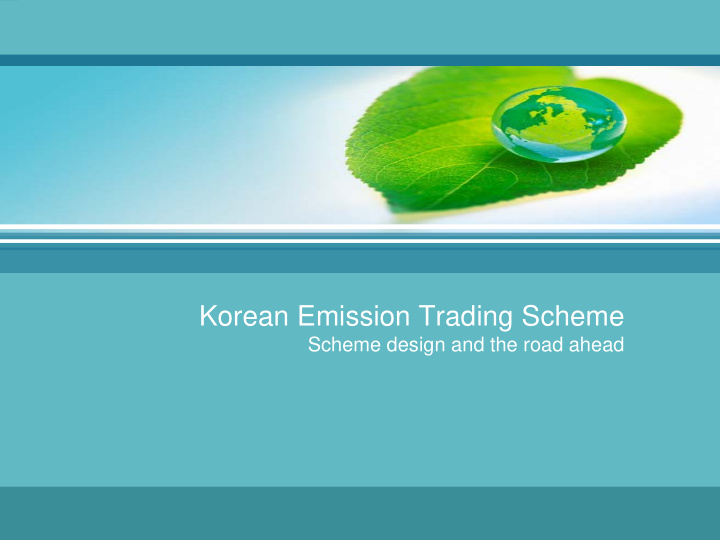



. . . Korean Emission Trading Scheme Scheme design and the road ahead
. Table of Content I. Overview II. Recent landmark on GHG mitigation III. Target Management Scheme IV. Emission Trading Scheme Design V. Road Ahead and Challenges 2
4-STEP Recent landmarks on GHG mitigation 서 Substantial progress in mitigation policy in the last few years 2012 • Emission Trading 2011 Legislation (May) • Sectoral Targets 2010 & the Presidential set for 2020 Decree (Nov) • Enacted the ‘Low 2009 passed Carbon Green • 2020 National Growth Act’ Reduction Target provisions for ETS set • Designed the Target (30% from BAU) management scheme (TMS) Implementation in 2012 4
The national target (2009) 서 Estimated that such ambition could imply some 233MT CO 2e reduction in 2020 from the business-as-usual scenario 776 unit: Mt CO 2 e 30% reduction (233 MT CO 2e ) 594 543 298 1990 2005 2020 Target 5
Sectoral targets (2011) 서 cc As a follow-up to the national target, emission pathway and sectoral reduction targets were set in July 2011 Sectoral targets (reduction from BAU) Agriculture & Industry Transport Buildings Fisheries Waste Public Total 18.2% 34.3% 26.9% 5.2% 12.3% 25.0% 30.0% 6 6
Target Management Scheme (TMS) 서 cc • Launched in 2012 TMS coverage • TMS covers 66% of total GHG emissions 67 % • Some 530 entities designated at the end of 2013 of total GHG emission s • Designation criteria Energy consumption criteria (terajoules) GHG emission criteria (CO 2e T) 125000 50000 87500 25000 entity 50000 20000 15000 facility 25000 20000 15000 500 350 before Dec. '11 after Jan '12 after Jan '14 before Dec. '11 after Jan '12 after Jan '14 7
Target Management Scheme (TMS) 서 cc Similarities to ETS Limitations • NO tradable emission permits • Measurement, Reporting and Verification (MRV) • NO flexibility Process (Banking/Borrowing) • Cap Setting Process • NO proportional penalty (only fixed penalty) • Led to the legislation of the “Greenhouse Gas Emission Permit Allocation and Trade Act ” (Bipartisan support in the National Assembly) 8
Emission Trading Scheme (Key Objective) 서 cc Reduce Promote GHG in a low-carbon cost- technology effective development manner & deployment 9
ETS (Key processes and legal plans) 서 cc Basic Plan • 10 year plan Basic Plan • Every 5 years Allocation • Ministry of Strategy and Plan Finance • Policy direction for ETS, BAU forecast, economic Submiss- impact assessment, etc. ion of Permits Designa- tion of Allocation Plan Entities • Every phase (3~5 yrs) • Ministry of Environment Reporting & • ETS cap, Cap for each Verification Allocation sector, Allocation of Permits methodology, • Reviewed by the Allocation Committee 10
ETS (Scheme design) 서 cc • Average emission of 3 years* prior to the implementation phase Coverage Entity criteria 125,000t CO 2e, Installation criteria 25,000t CO 2e • Voluntary participating entities Phase III Implementation phases & free Phase II • 2021~2025 allocation • Less than 90% Phase I • 2018~2020 free allocation • 97% free • 2015~2017 allocation An Implementation phase • 100% free 5 years from Phase III allocation • > 5% of production cost intensity + > 10% of trade- 100% free exposed intensity allocation for • > 30% of production cost intensity EITE entities • > 30% of trade-exposed intensity 11
ETS (Flexibility) 서 cc • Banking allowed to the next implementation year within Banking & the same phase or the 1 st year of the next phase Borrowing • Borrowing allowed from the next implementation year (max of 10% of total necessary permits for submission) • Max of 10% of total necessary permits for submission • International offsets are allowed starting in Phase III Offsets (50% of total offset permits) • Max of 3% of total necessary permits for submission (only for Phase I) Early Action 12
ETS (Adjustment, cancelation & fine) 서 cc • Adjustments in allocation of permits is possible when: - there is a change in the Allocation Plan; Adjustments • - there is request from entities for additional permit allocation due to unexpected expansion or merge acquisition and change in operation • Cancelation of permits is possible when: - there is a closure; Cancelation - delay in operation of over 3 month; or - suspension of operation of 1 year • Up to 3 times the average market price Fine for non- • Max of 100thousand KRW (US$ 91)/tCO 2e compliance 13
NAP (National Allocation Plan), Sep 2014 • 1,686 million KAUs(Korean Allowance Unit) from 2015 to 2017 - some 1,597 million KAUs to be allocated to entities before Cap starting - 89 million KAUs reserved in National Reserve for market stabilisation and additional allocation for expansion • 100% free allocation - Grandfathering based on historic emissions for electricity, steel, chemical and others(total 20 sub- Allocation sectors) - Benchmarking based on productivity for refinery, cement and domestic flight 14
Hurdles until legislation and NAP 서 cc Experts and NGOs Industry • Until legislation • Until legislation - Act now - Wait for international - momentum for green growth agreement and Act later - negative effects on national economy • Until NAP • Until NAP - Act now - Wait for international - momentum for low-carbon & agreement and Act later creative economy - negative effects on national - cap too high to boost economy technology investment - cap too low • Tens of public hearings, dozens of stakeholder meetings…. 15
ETS (Timetable for Phase I) 서 cc • Allocation finalized in the Allocation Approval Committee Nov 2014 • ETS phase I official launches • Permit Exchange Opens Jan 2015 • Submission of emissions report Mar 2016 • Submission of permits Jun 2016 • Submission of emissions report Mar 2017 • Submission of permits Jun 2017 • Phase 1 ends Dec 2017 16
Thank You 17
Recommend
More recommend